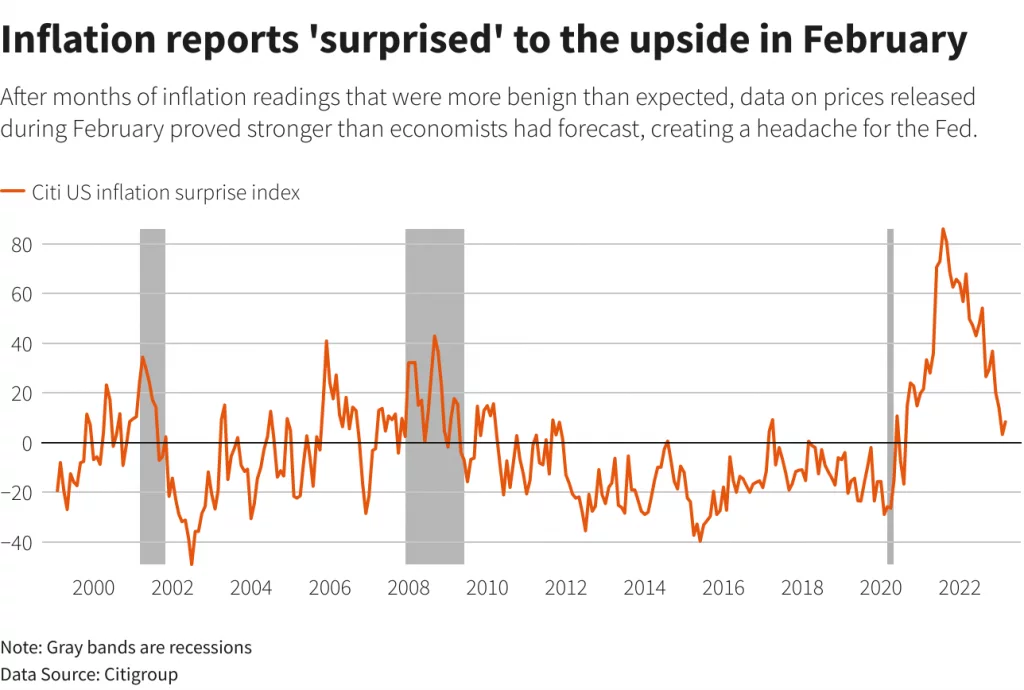Washington March 7 2023: The Federal Reserve will likely need to raise interest rates more than expected in response to recent strong data and is prepared to move in larger steps if the “totality” of incoming information suggests tougher measures are needed to control inflation, Fed Chair Jerome Powell told U.S. lawmakers on Tuesday.
“The latest economic data have come in stronger than expected, which suggests that the ultimate level of interest rates is likely to be higher than previously anticipated,” the U.S. central bank chief said in opening remarks at a hearing before the Senate Banking Committee.
While some of that unexpected economic strength may have been due to warm weather and other seasonal effects, Powell said the Fed was cognizant it may also be a sign it needs to do more to temper inflation, perhaps even returning to larger rate increases than the quarter-percentage-point steps officials had been planning to stick with.
“If the totality of the data were to indicate that faster tightening is warranted, we would be prepared to increase the pace of rate hikes,” Powell said.
The comments, his first since inflation unexpectedly jumped in January and the U.S. government reported an unusually large increase in payroll jobs for that month, sparked a quick repricing in bond markets as investors boosted bets to more than 70% that the Fed would approve a half-percentage-point rate increase at its upcoming March 21-22 meeting, and lift the anticipated endpoint for rate increases.
Powell’s statement was “surprisingly hawkish,” said Michael Brown, a market analyst with TraderX in London. With a 50-basis-point rate hike now in play, Brown said a strong monthly jobs report on Friday would likely lead to “calls for a 6% terminal rate,” nearly a percentage point higher than Fed officials had projected as of December.
The Fed’s benchmark overnight interest rate is currently in the 4.50%-4.75% range.
Even before Powell presented his testimony, the hearing began with a sharp prelude. U.S. Senator Sherrod Brown, the Democratic chair of the committee, said the Fed’s rate hikes ignored what he viewed as a chief cause of inflation – high corporate profits.
“Raising interest rates certainly won’t stop business from exploiting all these crises to jack up prices,” Brown said.
Senator Tim Scott, the highest ranking Republican on the panel and a possible 2024 presidential candidate, retorted that the Biden administration’s spending policies were more to blame.
With the next policy meeting two weeks away, the March 10 release of the Labor Department’s jobs report for February and an inflation report next week will be critical in shaping policymakers’ judgment about whether they are again slipping behind the inflation curve, or can stick with the more tempered policy planned at their last meeting.
In either case, Powell’s comments to the Senate committee members mark a stark acknowledgement that a “disinflationary process” he spoke of repeatedly in a Feb. 1 news conference may not be so smooth.
Although inflation “has been moderating,” since its peak last year, Powell said, “the process of getting inflation back down to 2% has a long way to go and is likely to be bumpy.”
Powell will testify again on Wednesday before the House of Representatives Financial Services Committee.

POSSIBLE LABOR MARKET SOFTENING
Powell’s testimony weighed in on an issue now at the center of Fed discussion as officials decide whether recent data will prove to be a “blip,” as one of his colleagues suggested, or be seen as evidence the central bank needs to lean on the economy even harder than currently expected.
In his testimony, Powell noted that much of the impact of the central bank’s monetary policy may still be in the pipeline, with the labor market still sustaining a 3.4% unemployment rate not seen since 1969, and strong wage gains.
In a comment that may well be seized on by some Senate Democrats, Powell suggested that the labor market might have to weaken for inflation to fall across the broad services sector, a labor-intensive part of the economy where prices continue to rise.
“To restore price stability, we will need to see lower inflation in this sector, and there will very likely be some softening in labor market conditions,” Powell said.
Powell’s last monetary policy report to Congress was in June, which was early in what became the most aggressive cycle of Fed rate increases since the 1980s. That monetary tightening has driven up borrowing costs for home mortgages, a topic of particular sensitivity for elected officials, contributed to volatility in traditional equity markets as well as alternative assets like cryptocurrencies, and sparked some broader debates about the Fed’s efficacy.
Inflation has fallen since Powell’s last appearances in Congress. After topping out at an annual rate of 9.1% in June, the Consumer Price Index dropped to 6.4% in January; the separate Personal Consumption Expenditures price index, which the Fed uses as the basis for its 2% target, peaked at 7% in June and had fallen to 5.4% as of January.










